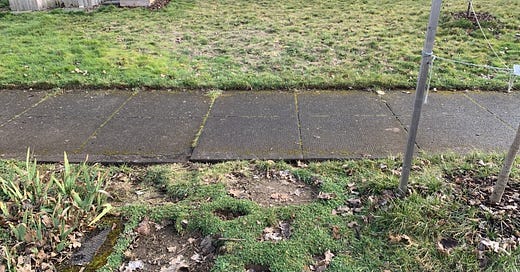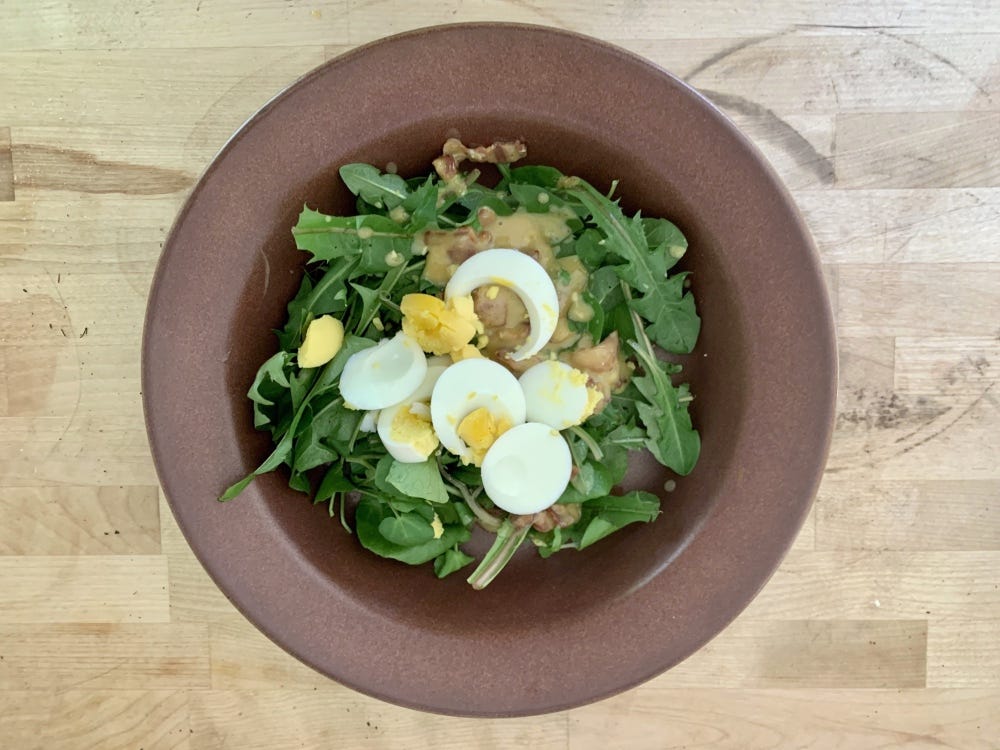Thanks so much to all you inaugural subscribers for signing up for “A Place Is a Gift”! I’m delighted, and also: The pressure is now officially on. (And if this is the first issue you’re encountering, here’s the introduction, plus a bit more about me and what I’m doing.)
We have lived in our house for two and a half years, and I have hated the front lawn since day one.
I hate the lawn on principle, because it's an artificial landscape that requires massive resources and chemicals to look good. I hate this lawn specifically, which is mangy and dandelion-ridden, and like most of my neighbors in North Portland, brown from June through November. My body hates the lawn, because I have to pop antihistamines and wear long pants in order to weed, dashing to the shower afterwards, skin prickling, before my eyes erupt.
This is the first property I have ever owned—though buying a 96-year-old house reinforces the realization that “owner” just means “temporary steward”—and this lawn, only strip of green I have ever tended. Sometimes this lawn still feels like an extravagance. During the first six months of the pandemic, it became a safety moat. My husband has turned the back lawn into a bee-loud retreat filled with flowers, but the front still radiates disdain and incompetence, no matter how many raised beds I replace the grass with.
Last month, I came across the website for the Backyard Habitat Certification Program, run by the Portland Audubon Society and Columbia Land Trust, which helps people in the Portland metro area replace lawns with fauna-friendly, pesticide-free native plants. That same day I sent the program $35 and requested an assessment. I mean, look at this. All these native, drought-tolerant flowers. These are meadows. Bees. Birds. Flowers. No grass.
I now have a packet of information on my desk listing the plants our assessor recommended, an appointment with a garden designer/coach to help me figure out how to get from weeds to meadow, and a sign informing our neighbors our Backyard Habitat Certification is pending, which I am too ashamed to put up at this point.
And yet, even as I have committed to kill the lawn, I have felt some need to pay my respects to it. So I finally made my Grandmother Nofziger's dandelion salad, which I've been curious about since my mother told me about it a few years ago.
There are two types of dandelions in our apocalypse of a yard. The majority are small, succulent, and furry, sprawling across the ground like tarantulas. The yard is covered with divots of bare ground where I have dug up their ancestors, and yet two years of obsessive weeding have barely thinned the population. That's because I give up by August, when the clay soil becomes too hard to pry taproots out of and the flowers go to seed with a taunting rapidity.
Every spring, though, a few of the good dandelions appear: The ones with thin, barbed leaves that look like miniatures of the dandelion greens I see at the farmers' market. Last week I scoured the grass for them, plucking individual leaves with the same tenderness I would reserve for arugula, and brought the dandelions into the kitchen to wash.
I have only faint memories of my maternal grandmother, who died when I was 8, and almost none of her food. In fact, this salad is one of only two childhood dishes my mother has ever reminisced about. She remembers picking weeds on their farm in western Ohio—it must have been the late 1940s or early 1950s, when the privations of the Depression and World War II still loomed over their lives. My grandmother would take the greens, make a warm, sweet-tart bacon gravy, and serve the wilted salad over boiled potatoes, scattering hard-boiled eggs over top.
When I found an online recipe for a Pennsylvania Dutch bacon dressing for dandelions, I sent the link to my mother. It looked right to her. There weren't enough of the good dandelion leaves for a one-person salad, so I added a few curls of watercress. Then I crisped up some bacon, and whisked beaten egg, vinegar, water, and sugar into the hot fat until it thickened. I spooned some over the bowl of greens, added chopped egg, and ate the salad over leftover whole grains in place of potato.
It was pleasantly unfamiliar, sweet and smoky. The dandelions' bitterness sounded a discordant note beneath the other flavors that nevertheless belonged there, like the drone of a bagpipe. Making dandelion salad for the first time felt like creating a memory of my grandmother to stand in for all the ones that never survived early childhood.
Eating dandelions out of my lawn also felt like an act of absolution, or perhaps a plea for forgiveness. At minimum, it marked a cessation of hostilities. For a few seconds, I regretted that I had not begun picking them earlier. They were delicious. I still want them dead.
A few more dandelion recipes:
Darra Goldstein's Dandelion Blossom Syrup (from Beyond the North Wind)
A 94-year-old cook recreates her favorite dandelion salad from the Depression:
About me: I'm a Beard Award-winning food journalist based in Portland, Oregon, and the author of Hippie Food, a history of the 1970s natural-foods movement. Read more stories at www.jonathankauffman.com.







I have a pot of pink dandelions that I grew from seed. That's right -- I spent two years coaxing these weeds from seed to flower, but now that they are mature, I have a handy source for young greens to add to my salads.
Oh my gosh, Jon, hilarious and touching. <3